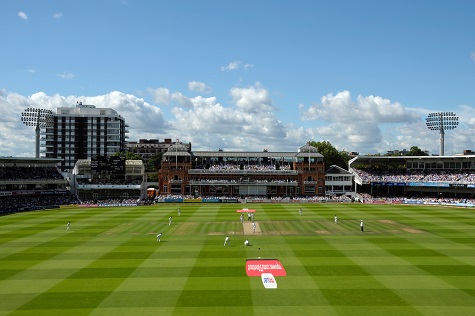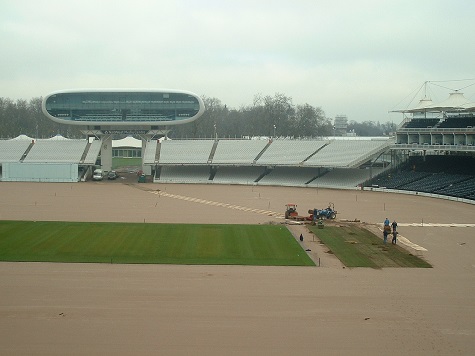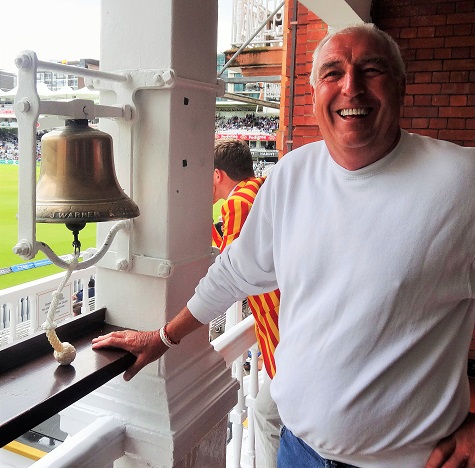“Lords is history modelled in turf and building” -
J M Kilburn
Look towards the sidescreen at the Nursery End during a Test Match, and you’ll often spot Mick Hunt in the groundsman’s ‘paddock’ beneath the Media Centre. Furrowed brow, arms folded, eyes searching the weather coming from the back of the Pavilion. Watching for signs when the grounds staff might have to rush onto the field for rain or bad light.
Mick spends a lot of time looking at the sky.
He’ll have all the latest weather gizmos at his disposal, but rather like a farmer, there is no substitute for having that in-built radar, for Mick Hunt’s ‘crop’ is the expanse of fine turf at the most celebrated cricket ground in the world.

Despite the changing face of architecture over the years, mixing old with the new, the focal point of Lord's Cricket Ground remains the playing surface. The pavilion, the stands, the hospitality boxes there to support the main purpose of the venue.
Like all professional groundsman, Mick Hunt is fiercely protective of his domain, no more so than the pitches prepared for Test Matches (normally two a year). “We treat them with kid gloves - and even get angry when someone looks at them!”
This week, Mick will prepare the stage for his last Test Match (England v India starting Thursday). His has been a remarkable, consistent and resilient career, rarely receiving the plaudits, in the firing line when things don’t go to plan - as is the groundsman's lot.
A keen club cricketer in his youth, he lived ‘a good six hit’ from Lord's and after seeing a vacancy joined the ground staff in 1969 working under head groundsman Jim Fairbrother who had taken over the role the previous year. After Fairbrother’s death in 1984, Mick was promoted to replace him thus becoming the 9th head groundsman at Lord's.
His first Test Match in charge was the Ashes Test Match of 1985, won by Australia by 4 wickets with Allan Border scoring 196 - so no gripes from the Aussies about the pitch prepared by the new man in charge.
Cricket is such a stats-driven game that it is worth reflecting on Mick Hunt’s contribution to major international games at Lord's. In the 49 years he has been at cricket headquarters, he will have been involved in preparing the playing surface for:
- 24 Test Matches working on groundstaff with Jim Fairbrother
- 63 Test Matches as Head Groundsman (including an Australia v Pakistan Test played at Lords in 2010 , and the 1970 England v Rest of World ‘Test’ which was not recognised officially)
- 12 One Day International working on groundstaff with Jim Fairbrother (inc 3 World Cup Finals)
- 50 One Day Internationals as Head Groundsman (inc one World Cup Final)
That’s a total of 149 Test Matches and ODIs - 113 of them as Head Groundsman.
With Lords hosting around 30 other matches this year, from the Royal London Cup Final to Twenty20 games and the National Village Cup Final, you can work out that Mick will have prepared over 4,000 pitches and outfields during his time at Lords.
OUTFIELDS AND OLYMPICS
For all its fabled ‘hallowed turf’ status the Lord's playing surface has is inperfections and has been a challenge to Mick over his whole career.
Notably the slope. The outfield falls 8ft 6” from the square which itself is not totally level. “If I could change one thing about Lord's, I’d like a nice, level square,” says Mick. “But to backfill and level the surface down to the Mound Stand you would need to dig up half of Lancashire” (and presumably lose several rows of seats).
But in 2003, that is exactly what they did to Lord's itself which had always been prone to flooding. “There has only to be a cloud in the sky for the ground to puddle,” he said. It was particularly bad in the early 80s when eight hours had been lost during the Test against India, over nine hours in the West Indies Test, and then embarrassingly ten hours during the showpiece Centenary Test in 1980 - which even resulted in a reported punch-up in the pavilion.
Lord's was built over dense London clay, surface water simply stayed where it lay and days of cricket were lost along with valuable revenues. The decision was taken to rip out the outfield, leaving Mick’s treasured square as a pristine island in the midst of acres of bare soil. Over the period September 2002 to April 2003, 16,000 tonnes of turf and top soil were removed involving 800 lorries. New drains, state-of-the-art irrigation systems and rootzone were put in before final turfing. For months the playing area looked like a building site, but come the Spring, spectators attending the first game of the season will have been visually unaware of the dramatic reconstruction of the ‘earth beneath’.

The £1.25 million expense was totally vindicated in 2007 on the second day of the Test Match against India. A thunderstorm hit the ground shortly after breakfast when over an inch of rain fell on the ground which soon resembled a lake. Before the outfield renovation, play would have been lost for the day, and possibly for a couple of days. Yet, spectators were amazed to see the water simply fall through the surface - and play commenced before lunchtime.
A re-turfing of the outfield was also required when Lord's was chosen as a venue for the 2012 Olympic archery competition. A full programme of cricket was played until 1 July after which control of the venue passed from the MCC to the International Olympic Committee. You can imagine that Mick Hunt was not too chuffed, within weeks his outfield was filled with stands holding 5,000 people. The square however was out-of-bounds so that regular mowing and maintenance could continue.

The archery final took place on 3 August and the race was then on for Mick and his team to return Lord's to its pristine state in readiness for a Test Match against South Africa on 16 August. A third of the outfield was relayed and on the opening day the ground presented itself to players and spectators with little sign of the enormous upheaval. It had been an ‘Olympian’ feat by Mick, his grounds crew and the turf contractors. “Afterwards, the pitch was marked as very good by the match referee,” said Mick with a mixture of pride and relief.
KEEPER’S VIEW
It is clear that Mick is highly regarded by players, umpires and officials. He has a good relationship with them, they trust him and value his knowledge and integrity. We were chatting on the boundary edge some years ago during a county match when Justin Langer (then Middlesex captain) walked by. “Great track, Mick, great track,” he said. But then he just had scored a big hundred. “Not sure the opposition bowlers would agree,” said Mick, “but then my yardstick for how a pitch is performing is always the keeper. They know how it is coming through, how it’s hitting gloves. My overriding aim has always been to produce a pitch that provides a good contest.”
Like every Test Match venue, the ‘strip’ is analysed, prodded and poked, filmed in macro-detail and analysed to the ‘nth-degree. Steve Birks, head groundsman at Trent Bridge once described the pressures; “Sometimes it’s so much hassle, it’s as if we were dealing with a nuclear weapon not a cricket pitch! Looking after the ground is easy, the hardest job is dealing with people.”
The scrutiny today is much more intense than it was when Mick took over as head groundsman with administrators, television companies, the media all pitching in to give their views on 22 yards of living, breathing, wearing material.
Mick Hunt has always presented a self-effacing, quiet, critical approach to his role. Fame and adulation does not sit easily with him. Describe him as a legend of his profession and he’ll shrug off the compliment. It is clear that the MCC have enormous respect for the person who has looked after their most valuable asset for almost half a century. They also know that he is very much his own man, does things his way with the interest of Lord's and the game of cricket always at heart.
As the longest serving MCC staff member, Mick was recognised by the MCC in 2014 when he was invited to ring the 5 minute bell before the start of the MCC Bicentenary match against the Rest of the World XI. He was delighted at the honour, but still looked a little embarrassed at the inevitable media coverage.

The MCC has a history of promoting from within their own ranks, so whilst the search for the next head groundsman will be a high-profile process - the groundwork, the team-spirit and the experience of senior colleagues working with Mick over the years will surely count for something.
Mick Hunt deserves the thanks of all cricket lovers and all those who revere the history and traditions of Lord's for being the ‘guvnor of grass’ for all these years.
We’ll miss the sight of him, in shorts, following his crew out to the middle during a crucial game, directing operations, having a quiet word with officials. Involved, committed, caring deeply for his Lord's.
His Test Match finale is beautifully set up following England’s victory over India on Saturday. A game played on a terrific, fair and sporting pitch prepared by Edgbaston’s Gary Barwell and you can be assured that the Lord's pitch will have been prepared to the same criteria.
Acknowledging that Mick will be a ‘tough act to follow’, John Stephenson, MCC Assistant Secretary says, “Mick Hunt’s place in the history of Lord's is assured”. Indeed, he has been involved in grounds preparation for a quarter of the time that Lords has hosted cricket.
All those in the turfgrass profession to whom he has been a role-model, all those in the world of cricket, will wish Mick Hunt a long and healthy retirement, and rather inadequately, say a heartfelt “Thank you!”
Chris Biddle is Consultant Editor of TurfPro and has been an MCC member for 55 years
Acknowledgments:
Thanks to the MCC for the image of Lord's (Sarah Williams) and James Glenday (ABC News)
I also reference the following books for quotes and facts:
A Portrait of Lord's: Adam Chadwick
Lord's, A Celebration in Pictures: Andrew Strauss OBE
The Complete Lord's Tests, 1884 - 2013: Jonathan Rice
The Forgiveness of Nature: Graham Harvey